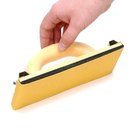Whether you call it pleather or faux leather, artificial leather differentiates itself from the real thing in many ways -- it offers a lower price tag, a wider variety of shades and textures and an increased resistance to the elements. But what faux leather has in gloss and color, it often lacks in the potential for patina; the genuine article takes on a naturally worn texture through simple, day-to-day use, but poly-leathers may need a little coaxing to get that edgy, lived-in look. To customize your look, start with gentle distressing techniques, then ramp up the intensity to suit your tastes.
Rub the surface of the garment with fine-grit sandpaper, rated at around 150 or 200 grit, using a very gentle back-and-forth motion. Faux leather items typically feature a thin outer layer of leather-like plastic or vinyl over a filler material of a different color; sanding too hard or too much will likely crack the fake leather layer and reveal the filler, which may or may not be to your liking – go easy at first and ramp up the sanding to create a more distressed look. Focus your sanding on areas that would naturally wear out over time, such as edges and seams.
Wrap the head of a hammer with a thick rag, place the garment on a hard work surface and beat the areas of the item that would naturally age the most, such as the hemlines of a jacket or the toe-caps and heels of a pair of boots. This softens the fabric and adds visually interesting imperfections and creases.
Spray the pleather with a solution of half water and half rubbing alcohol or witch hazel, coating the fabric's surface. Rub selected areas of the garment -- again, focusing on places likely to see the most use -- with another round of sandpaper to fade the item's color. For heavy-duty distressing, spray the poly-leather with the solution and brush it with a wire brush, leaving scratches across the material. Brush in crisscrossing directions to create a crosshatch pattern on the fabric.
Beat the faux leather with a meat tenderizer or drag the textured surface of the tenderizer across the garment to further roughen its surface. You can also streak the fabric with flat black spray paint to create additional patina. Work on a covered surface outdoors or in a well-ventilated area, wearing eye protection, gloves and a dust mask, and hold the spray can about 18 inches away from the item, applying it with a streaking motion. This works best when spraying upward toward the bottom of the garment, giving the edges a subtly darkened, aged look. Reserve these techniques for pieces of clothing you really want to age heavily.
Related Articles

How to Make Faux Leather Look Real

How to Make Your Carhartt Jackets Look ...

How to Distress Fabric

How to Fix Pants That Have a Shiny ...

Making Leather Less Stiff

How to Waterproof a Leather Jacket

How to Dye Faux Leather

How to Darken Faded Black Leather

How to Spot a Knockoff North Face ...

How to Care for Suede & Leather

Qualities of Crepe Wool Fabric

How to Distress Clothing and Baseball ...

How to Care for Nubuck Leather

How to Whiten Yellowed Leather Shoes

How to Remove Makeup From a Black Suit ...

How to Make Faux Leather Jackets Last ...

How to Care for Leather Pants

How to Clean Suit Jackets

How to Defuzz a New Fleece Jacket

What Is Cognac Leather?
References
Writer Bio
With a diverse professional background and a decade of experience as a freelance writer, Dan has contributed lifestyle content -- from fashion to travel to fitness and more -- to publishers including Chron, Fortune, Sony, GlobalPost, ModernMom, Moviefone, Salon.com, Techwalla and dozens of others.